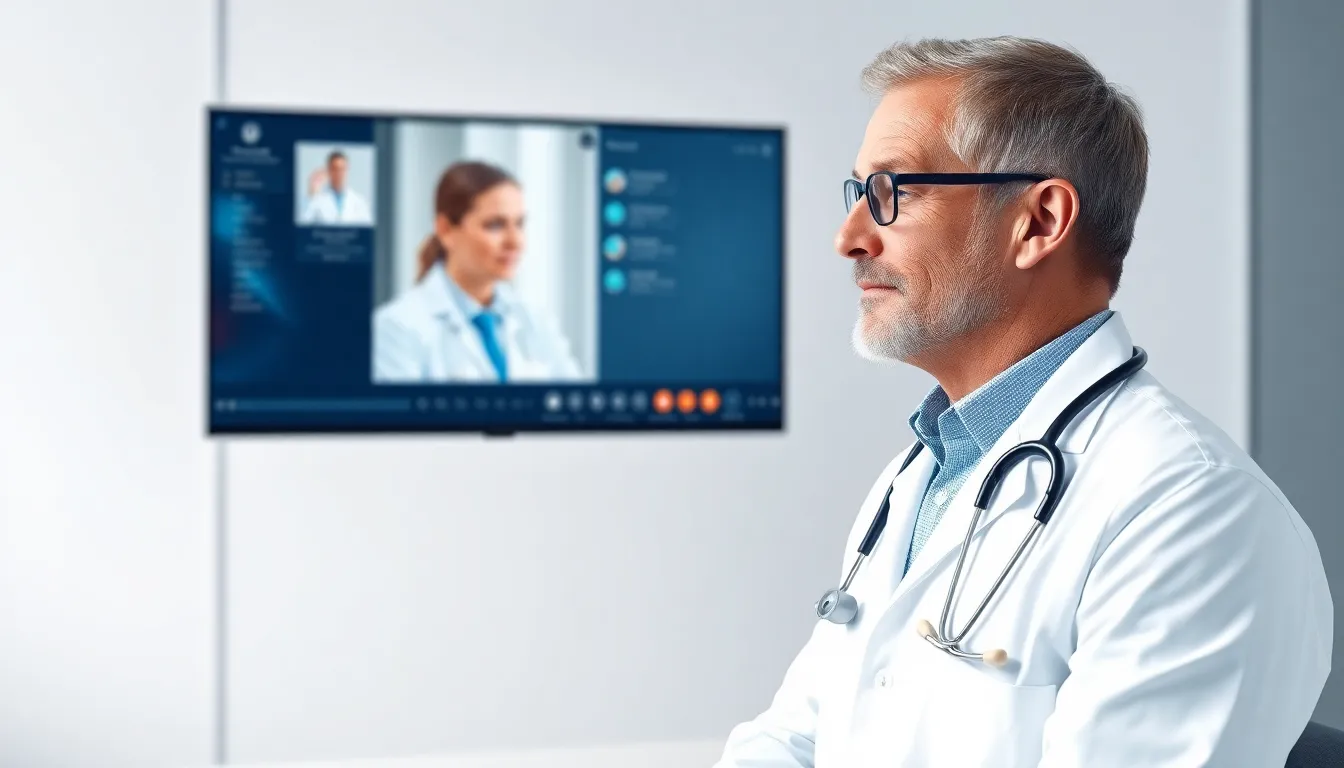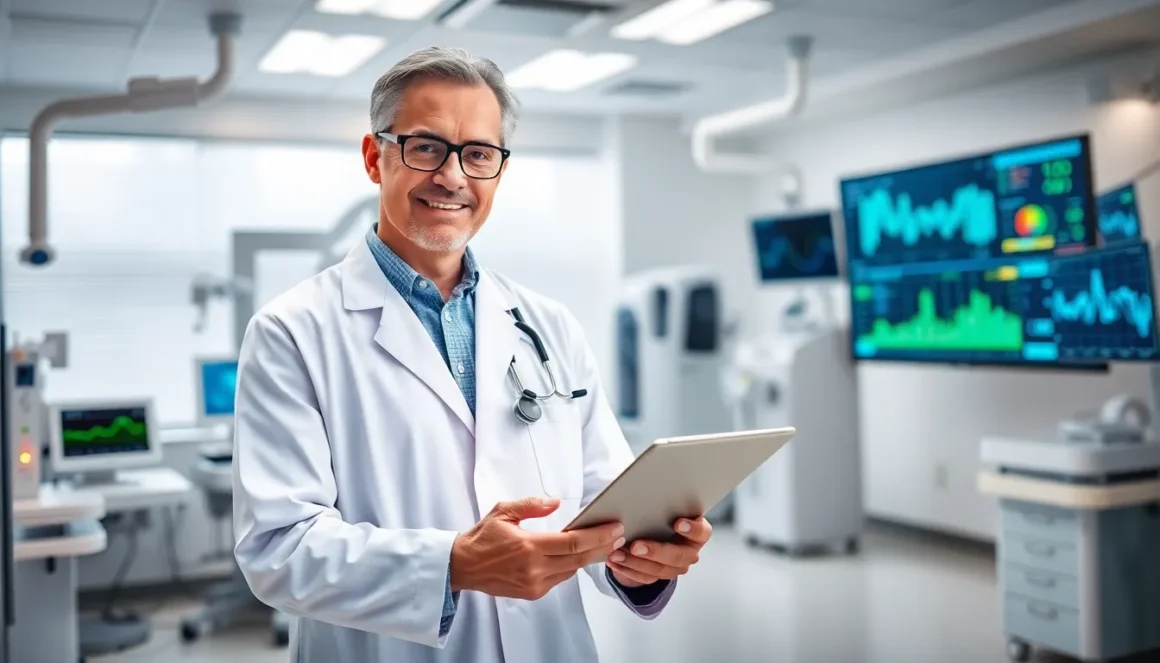Imagine a world where a doctor can diagnose a patient from miles away, all thanks to lightning-fast 5G technology. It’s not just a sci-fi movie plot; it’s the future of healthcare unfolding right before our eyes. With 5G, healthcare is set to leap into a new era, where connectivity meets innovation, and patients can receive care like never before.
5g mobile technology in healthcare
5G mobile technology represents the fifth generation of wireless communication, offering significantly higher speeds and lower latency compared to previous generations. With download speeds reaching up to 10 Gbps, 5G facilitates rapid data transfer, crucial for real-time applications in healthcare. Hospitals gain the ability to manage large volumes of data generated by medical devices seamlessly.
Low latency, often around 1 millisecond, plays a vital role in remote surgery and telemedicine. Surgeons can operate robotic instruments with precision, no matter the distance. Enhanced connectivity transforms patient monitoring systems, enabling healthcare professionals to track vital signs in real-time, even from patients’ homes.
Additionally, 5G supports the Internet of Medical Things (IoMT), connecting devices such as wearable health monitors and smart medical equipment. Hospitals can analyze data from these devices instantly, allowing for timely interventions. The number of devices connecting simultaneously improves, supporting more patients without decline in service quality.
Furthermore, 5G networks offer improved reliability and security, which are crucial in handling sensitive health information. Healthcare organizations can leverage this technology to protect patient data while maintaining high operational standards. Such advancements promise a shift towards more proactive, data-driven healthcare delivery.
5G mobile technology revolutionizes healthcare by enhancing connectivity, enabling advanced applications, and improving patient outcomes. The evolution of healthcare systems becomes increasingly reliant on these technological advancements, ensuring that care becomes more efficient and personalized.
Impact of 5G Mobile Technology in Healthcare

5G mobile technology significantly transforms healthcare, enhancing patient care and operational efficiency using advanced connectivity.
Enhanced Telemedicine Services
Telemedicine benefits greatly from 5G’s low latency and high-speed capabilities. Physicians can conduct real-time video consultations, ensuring that patients receive timely diagnoses. Quick data transfer allows for seamless sharing of medical records and imaging between practitioners. Enhanced video quality improves the clarity of consultations, fostering better communication between doctors and patients. Remote care becomes more accessible, especially in rural areas, where specialized services often lack. Utilizing 5G, healthcare professionals gain the tools to provide immediate attention, reducing wait times for patients and streamlining overall healthcare services.
Improved Remote Patient Monitoring
Remote patient monitoring evolves with 5G’s robust connectivity, enabling healthcare providers to track patients’ vital signs in real-time. Wearable devices transmit health information seamlessly, facilitating timely interventions for chronic conditions. Instant data analysis becomes possible, allowing for quicker responses to fluctuations in health status. Continuous monitoring helps build stronger patient-provider relationships, as healthcare teams stay informed about patients’ conditions. Moreover, 5G supports the Internet of Medical Things, connecting multiple devices to enhance data accuracy and reliability. Overall, improved remote monitoring ensures that patients receive personalized care tailored to their evolving health needs.
Applications of 5G in Healthcare
5G technology significantly enhances healthcare applications, streamlining patient care while improving overall health outcomes. This innovation supports a range of advanced solutions.
Smart Wearables and Health Devices
Smart wearables and health devices benefit greatly from 5G connectivity. Devices like fitness trackers and smartwatches transmit data quickly, providing accurate health metrics. They’re connected continuously to healthcare systems, enabling real-time monitoring of vital signs like heart rate and blood pressure. Enhanced connectivity simplifies patient engagement, allowing users to receive instant feedback on their health. Innovations in wearables also include advanced solutions for chronic diseases, making it easier to manage conditions with timely alerts and notifications.
Real-Time Data Transmission
Real-time data transmission transforms how healthcare providers access patient information. 5G infrastructure allows for rapid data transfers, minimizing delays in retrieving critical medical records. Surgeons rely on this prompt access when conducting remote operations using robotic instruments. Efficient data handling improves collaboration between specialists, enabling timely decision-making during emergencies. Enhanced bandwidth supports high-definition streaming, making telemedicine consultations clearer and more effective. As a result, healthcare organizations can deliver prompt, informed, and personalized patient care.
Challenges and Considerations
5G technology in healthcare presents several challenges that organizations must address for successful implementation.
Security Concerns
Security remains a top priority as healthcare systems integrate 5G. Rapid data transfer increases vulnerability to cyberattacks, exposing sensitive patient information. With 10 Gbps download speeds, hackers can exploit weaknesses in connected devices and networks in less time. Strong encryption methods are critical for safeguarding data. Compliance with regulations like HIPAA ensures that organizations maintain the privacy and security of health information. Continuous monitoring also plays a role in identifying potential breaches and vulnerabilities. Healthcare providers must collaborate with cybersecurity experts to create robust defense strategies.
Infrastructure Requirements
Adopting 5G requires significant infrastructure investments. Hospitals and healthcare facilities must upgrade existing systems to handle the technology’s complexities. High-density antennas and reliable network coverage are essential components for seamless connectivity. Successful implementation often demands collaboration with telecom providers for network expansion. Training staff on utilizing new technologies enhances efficiency and care delivery. Additionally, organizations may need to assess current hardware and software compatibility to integrate 5G effectively. Upfront investment correlates with long-term benefits, making wise planning crucial for healthcare transformation.
Conclusion
5G mobile technology is set to redefine the healthcare landscape. Its unparalleled speed and low latency pave the way for innovative solutions that enhance patient care and streamline operations. As healthcare providers embrace this technology they’ll unlock new possibilities for remote monitoring and telemedicine.
The integration of 5G will not only improve patient outcomes but also foster collaboration among healthcare professionals. While challenges like security and infrastructure investment remain it’s clear that the benefits of 5G in healthcare far outweigh the hurdles. As this technology continues to evolve healthcare organizations must prioritize strategic planning and robust security measures to fully harness its potential.


